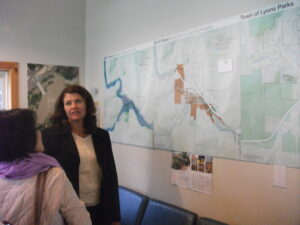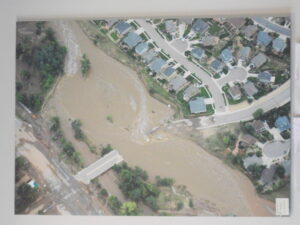Ten years ago this month, Colorado faced a crisis. Following previous years of drought and wildfires, Rocky Mountain monsoon rains dumped a year’s worth of precipitation on the Front Range in a single day. Water poured down mountainsides that were sometimes so parched and scorched from previous high heat and fires that they could not absorb the rainfall, which then carried mud and debris downhill through the towns in its path. One of those towns was Lyons, which we visited on July 13 to interview Town Administrator Victoria Simonsen, who has remained on the job through thick and thin, helping to guide a remarkable recovery. But she also helped arrange for us to interview homeowner Priscilla Cohan, who is also a local artist, and Neil Sullivan, owner of the St. Vrain Market local grocery store. He has also served on the town’s planning commission, and his wife served two terms as mayor during the recovery.
Click here to watch the blog video recorded in Lyons.
I had previously visited Lyons twice in the early years after the flood, discussing some of the situation in an early blog post here. During the same time, a Community Planning Assistance Team (CPAT) from the American Planning Association spent several days visiting Lyons and producing a report with its own recommendations for moving forward. Lyons received other outside help too, from agencies like the Federal Emergency Management Agency, of course, but also from entities like the planning school at the University of Colorado at Denver.
Now, the town is moving forward this month with a commemoration of that infamous flood that divided this Rocky Mountain hillside community into six islands divided by flood waters, compounding the difficulties of search and rescue until the flood waters receded. Why did we go there now? We wanted to capture this story and learn how it fit into a larger story of the State of Colorado building capacity for local governments to develop resilience in the face of cascading disasters like drought, wildfires, landslides, and flooding. We will integrate that story into the final film product for Planning to Turn the Tide, made possible by the assistance of people like Simonsen and numerous other volunteers from the Colorado APA Chapter and the Colorado planning community.
If you wish to support this endeavor, please use the QR code below or link here.
Jim Schwab



